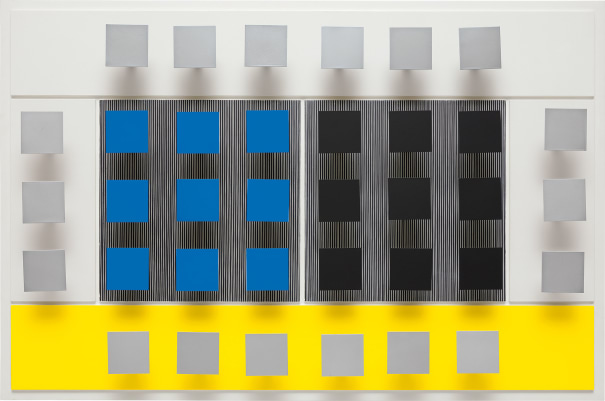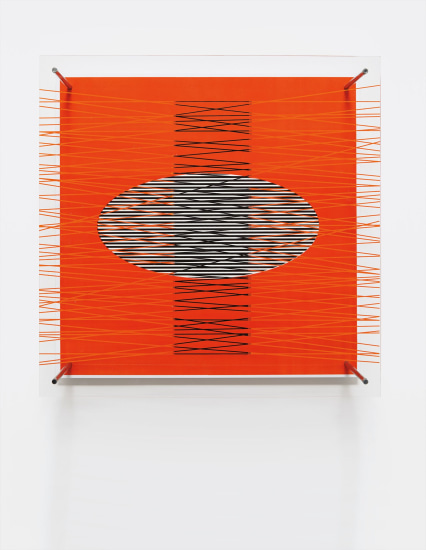Jesús Rafael Soto Follow Rectangles et Carres signed, titled and dated "RECTANGLES ET CARRES Soto 1969" on the reverse acrylic on wood and metal 54 1/2 x 42 x 6 1/2 in. (138.4 x 106.7 x 16.5 cm.) Executed in 1969.
Condition Report Request Condition Report Thank you for your request. The Condition Report will be sent shortly. Contact Us * Required Send me the Report Via Email Fax Contact Specialist Cancel Provenance Galerie Denise René, New York Francisco Narvaez, Caracas Private Collection, Caracas (by descent from the above) Acquired from the above by the present owner Catalogue Essay Produced at the height of Jesús Rafael Soto’s career, Rectangles et Carres is a testament to the artist’s aim of advancing the limits of geometric abstraction. The horizontal line dividing the bright yellow and white rectangles from the darker, busier elements in the lower panel of the composition evokes a childhood memory, which Soto described in conversation with Ariel Jiménez: “I remember the awe I felt seeing the vibration of the air through the reflection of the sun on the earth. I never got tired of seeing that vibrating mass floating in space and shining over the road.” The three-dimensional squares over the striped background, a staple of Soto's groundbreaking kinetic art, express that vibration in painting as a result of movement and light. The year 1969 represented the culmination of a decade during which Soto’s mature style emerged. Having grown up and studied figurative art in Venezuela, the artist immigrated to Paris in the early 1950s, immersing himself in the artistic post-war scene. This move was propelled by a creative epiphany that Soto experienced after hearing an acquaintance skeptically describe Malevich’s White on White , 1918 painting. Although he would not see this painting until years later, he immediately understood its far reaching implications. The conceptual nature of this insight reflects Soto’s approach to art, not as a creative or political expression, but as a form of knowledge akin to philosophical and scientific investigation. Soto’s recurring use of the square stems from its abstract purity and independence from the human scale, which allowed him to break free from the constraints of classical composition and anthropocentrism. It is no wonder that he considered Mondrian to be the most significant abstract painter of his time. Addressing the unresolved tension inherent to Mondrian's work between the intersection of the vertical and horizontal axes, Soto's innovation was to add a third dimension to his works, achieving the sense of vibration that had inspired him since his youth. The importance of Rectangles et Carres is further attested by its provenance. Originally sold by the gallery that first brought Soto’s work to prominence in Paris in 1955, this work belonged to the Venezuelan sculptor Francisco Narvaez. A compatriot from an earlier generation, Narvaez studied art in Paris, but returned to Venezuela in 1931, dedicating himself to expressing the local culture and ethnicity in a modern, artistic language. In a sense, the work of Narvaez’s generation paved the way for a cosmopolitan generation of post-war artists that fully embraced the universal, as the problem of local identity had already been widely investigated, if not resolved. Soto’s fascination with light was not specific to his tropical upbringing, but rather an instinctive curiosity towards the most basic, universal phenomenon. As Soto realized when first viewing the paintings of Vermeer, his aim was to capture the universality of light, movement, and vibration. Read More Artist Bio Jesús Rafael Soto Venezuelan • 1923 - 2005 Follow Jesús Rafael Soto was born in Ciudad Bolívar and studied at the School of Visual and Applied Arts in Caracas. During this period he became acquainted with Los Disidentes, a group of artists that included Alejandro Otero and Carlos Cruz-Diez In addition to his fellow compatriots, Soto’'s work was influenced by Kazimir Malevich and Piet Mondrian The main artistic tenets evinced in Soto's works are pure abstraction, vibrations, progressions and geometric rigor. They can be seen through the use of lines and superimposed squares
Jesús Rafael Soto Follow Rectangles et Carres signed, titled and dated "RECTANGLES ET CARRES Soto 1969" on the reverse acrylic on wood and metal 54 1/2 x 42 x 6 1/2 in. (138.4 x 106.7 x 16.5 cm.) Executed in 1969.
Condition Report Request Condition Report Thank you for your request. The Condition Report will be sent shortly. Contact Us * Required Send me the Report Via Email Fax Contact Specialist Cancel Provenance Galerie Denise René, New York Francisco Narvaez, Caracas Private Collection, Caracas (by descent from the above) Acquired from the above by the present owner Catalogue Essay Produced at the height of Jesús Rafael Soto’s career, Rectangles et Carres is a testament to the artist’s aim of advancing the limits of geometric abstraction. The horizontal line dividing the bright yellow and white rectangles from the darker, busier elements in the lower panel of the composition evokes a childhood memory, which Soto described in conversation with Ariel Jiménez: “I remember the awe I felt seeing the vibration of the air through the reflection of the sun on the earth. I never got tired of seeing that vibrating mass floating in space and shining over the road.” The three-dimensional squares over the striped background, a staple of Soto's groundbreaking kinetic art, express that vibration in painting as a result of movement and light. The year 1969 represented the culmination of a decade during which Soto’s mature style emerged. Having grown up and studied figurative art in Venezuela, the artist immigrated to Paris in the early 1950s, immersing himself in the artistic post-war scene. This move was propelled by a creative epiphany that Soto experienced after hearing an acquaintance skeptically describe Malevich’s White on White , 1918 painting. Although he would not see this painting until years later, he immediately understood its far reaching implications. The conceptual nature of this insight reflects Soto’s approach to art, not as a creative or political expression, but as a form of knowledge akin to philosophical and scientific investigation. Soto’s recurring use of the square stems from its abstract purity and independence from the human scale, which allowed him to break free from the constraints of classical composition and anthropocentrism. It is no wonder that he considered Mondrian to be the most significant abstract painter of his time. Addressing the unresolved tension inherent to Mondrian's work between the intersection of the vertical and horizontal axes, Soto's innovation was to add a third dimension to his works, achieving the sense of vibration that had inspired him since his youth. The importance of Rectangles et Carres is further attested by its provenance. Originally sold by the gallery that first brought Soto’s work to prominence in Paris in 1955, this work belonged to the Venezuelan sculptor Francisco Narvaez. A compatriot from an earlier generation, Narvaez studied art in Paris, but returned to Venezuela in 1931, dedicating himself to expressing the local culture and ethnicity in a modern, artistic language. In a sense, the work of Narvaez’s generation paved the way for a cosmopolitan generation of post-war artists that fully embraced the universal, as the problem of local identity had already been widely investigated, if not resolved. Soto’s fascination with light was not specific to his tropical upbringing, but rather an instinctive curiosity towards the most basic, universal phenomenon. As Soto realized when first viewing the paintings of Vermeer, his aim was to capture the universality of light, movement, and vibration. Read More Artist Bio Jesús Rafael Soto Venezuelan • 1923 - 2005 Follow Jesús Rafael Soto was born in Ciudad Bolívar and studied at the School of Visual and Applied Arts in Caracas. During this period he became acquainted with Los Disidentes, a group of artists that included Alejandro Otero and Carlos Cruz-Diez In addition to his fellow compatriots, Soto’'s work was influenced by Kazimir Malevich and Piet Mondrian The main artistic tenets evinced in Soto's works are pure abstraction, vibrations, progressions and geometric rigor. They can be seen through the use of lines and superimposed squares










Try LotSearch and its premium features for 7 days - without any costs!
Be notified automatically about new items in upcoming auctions.
Create an alert